+ Open data
Open data
- Basic information
Basic information
| Entry | Database: PDB / ID: 7kjp | |||||||||||||||
|---|---|---|---|---|---|---|---|---|---|---|---|---|---|---|---|---|
| Title | Disulfide Stabilized Norovirus GI.1 VLP Shell Region | |||||||||||||||
 Components Components | Capsid protein VP1 | |||||||||||||||
 Keywords Keywords | VIRUS LIKE PARTICLE / Norovirus / Stabilized / VLP / Shell | |||||||||||||||
| Function / homology |  Function and homology information Function and homology informationT=3 icosahedral viral capsid / host cell cytoplasm / identical protein binding Similarity search - Function | |||||||||||||||
| Biological species |  | |||||||||||||||
| Method | ELECTRON MICROSCOPY / single particle reconstruction / cryo EM / Resolution: 3.86 Å | |||||||||||||||
 Authors Authors | Gorman, J. / Kwong, P.D. | |||||||||||||||
| Funding support |  United States, 4items United States, 4items
| |||||||||||||||
 Citation Citation |  Journal: NPJ Vaccines / Year: 2020 Journal: NPJ Vaccines / Year: 2020Title: Disulfide stabilization of human norovirus GI.1 virus-like particles focuses immune response toward blockade epitopes. Authors: Raffaello Verardi / Lisa C Lindesmith / Yaroslav Tsybovsky / Jason Gorman / Gwo-Yu Chuang / Caitlin E Edwards / Paul D Brewer-Jensen / Michael L Mallory / Li Ou / Arne Schön / Wei Shi / Ena ...Authors: Raffaello Verardi / Lisa C Lindesmith / Yaroslav Tsybovsky / Jason Gorman / Gwo-Yu Chuang / Caitlin E Edwards / Paul D Brewer-Jensen / Michael L Mallory / Li Ou / Arne Schön / Wei Shi / Ena S Tully / George Georgiou / Ralph S Baric / Peter D Kwong /  Abstract: Human noroviruses are non-enveloped, single-strand RNA viruses that cause pandemic outbreaks of acute gastroenteritis. A bivalent vaccine containing GI.1 and GII.4 virus-like particles (VLPs) has ...Human noroviruses are non-enveloped, single-strand RNA viruses that cause pandemic outbreaks of acute gastroenteritis. A bivalent vaccine containing GI.1 and GII.4 virus-like particles (VLPs) has been shown to be safe and highly immunogenic, but its efficacy and durability have been limited. Here, we show that norovirus GI.1 VLPs are unstable and contain a substantial fraction of dissociated VLP components. Broadly reactive, non-neutralizing antibodies isolated from vaccinated donors bound to the dissociated components, but not to the intact VLPs. Engineering of interprotomer disulfide bonds within the shell domain prevented disassembly of the VLPs, while preserving antibody accessibility to blockade epitopes. Without adjuvant, mice immunized with stabilized GI.1 VLPs developed faster blockade antibody titers compared to immunization with wild-type GI.1 VLPs. In addition, immunization with stabilized particles focused immune responses toward surface-exposed epitopes and away from occluded epitopes. Overall, disulfide-stabilized norovirus GI.1 VLPs elicited improved responses over the non-disulfide-stabilized version, suggesting their promise as candidate vaccines. | |||||||||||||||
| History |
|
- Structure visualization
Structure visualization
| Movie |
 Movie viewer Movie viewer |
|---|---|
| Structure viewer | Molecule:  Molmil Molmil Jmol/JSmol Jmol/JSmol |
- Downloads & links
Downloads & links
- Download
Download
| PDBx/mmCIF format |  7kjp.cif.gz 7kjp.cif.gz | 116 KB | Display |  PDBx/mmCIF format PDBx/mmCIF format |
|---|---|---|---|---|
| PDB format |  pdb7kjp.ent.gz pdb7kjp.ent.gz | 80.5 KB | Display |  PDB format PDB format |
| PDBx/mmJSON format |  7kjp.json.gz 7kjp.json.gz | Tree view |  PDBx/mmJSON format PDBx/mmJSON format | |
| Others |  Other downloads Other downloads |
-Validation report
| Summary document |  7kjp_validation.pdf.gz 7kjp_validation.pdf.gz | 1.3 MB | Display |  wwPDB validaton report wwPDB validaton report |
|---|---|---|---|---|
| Full document |  7kjp_full_validation.pdf.gz 7kjp_full_validation.pdf.gz | 1.3 MB | Display | |
| Data in XML |  7kjp_validation.xml.gz 7kjp_validation.xml.gz | 34.9 KB | Display | |
| Data in CIF |  7kjp_validation.cif.gz 7kjp_validation.cif.gz | 46.4 KB | Display | |
| Arichive directory |  https://data.pdbj.org/pub/pdb/validation_reports/kj/7kjp https://data.pdbj.org/pub/pdb/validation_reports/kj/7kjp ftp://data.pdbj.org/pub/pdb/validation_reports/kj/7kjp ftp://data.pdbj.org/pub/pdb/validation_reports/kj/7kjp | HTTPS FTP |
-Related structure data
| Related structure data |  22897MC M: map data used to model this data C: citing same article ( |
|---|---|
| Similar structure data |
- Links
Links
- Assembly
Assembly
| Deposited unit | 
|
|---|---|
| 1 | x 60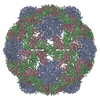
|
| 2 |
|
| 3 | x 5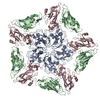
|
| 4 | x 6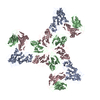
|
| 5 | 
|
| Symmetry | Point symmetry: (Schoenflies symbol: I (icosahedral)) |
- Components
Components
| #1: Protein | Mass: 56664.961 Da / Num. of mol.: 3 / Fragment: shell region Source method: isolated from a genetically manipulated source Source: (gene. exp.)  Norwalk virus (strain GI/Human/United States/Norwalk/1968) Norwalk virus (strain GI/Human/United States/Norwalk/1968)Strain: GI/Human/United States/Norwalk/1968 / Gene: ORF2 / Cell line (production host): Sf9 / Production host:  Has protein modification | Y | |
|---|
-Experimental details
-Experiment
| Experiment | Method: ELECTRON MICROSCOPY |
|---|---|
| EM experiment | Aggregation state: PARTICLE / 3D reconstruction method: single particle reconstruction |
- Sample preparation
Sample preparation
| Component | Name: Norovirus Hu/1968/US / Type: VIRUS / Entity ID: all / Source: RECOMBINANT |
|---|---|
| Source (natural) | Organism:  Norovirus Hu/1968/US Norovirus Hu/1968/US |
| Source (recombinant) | Organism:  |
| Details of virus | Empty: YES / Enveloped: NO / Isolate: OTHER / Type: VIRUS-LIKE PARTICLE |
| Natural host | Organism: Homo sapiens |
| Buffer solution | pH: 7.4 |
| Buffer component | Name: PBS |
| Specimen | Embedding applied: NO / Shadowing applied: NO / Staining applied: NO / Vitrification applied: YES |
| Specimen support | Grid material: COPPER / Grid type: C-flat-1.2/1.3 |
| Vitrification | Instrument: FEI VITROBOT MARK IV / Cryogen name: ETHANE |
- Electron microscopy imaging
Electron microscopy imaging
| Experimental equipment |  Model: Titan Krios / Image courtesy: FEI Company |
|---|---|
| Microscopy | Model: FEI TITAN KRIOS |
| Electron gun | Electron source:  FIELD EMISSION GUN / Accelerating voltage: 300 kV / Illumination mode: FLOOD BEAM FIELD EMISSION GUN / Accelerating voltage: 300 kV / Illumination mode: FLOOD BEAM |
| Electron lens | Mode: BRIGHT FIELD / Cs: 2.7 mm / C2 aperture diameter: 70 µm |
| Specimen holder | Cryogen: NITROGEN / Specimen holder model: FEI TITAN KRIOS AUTOGRID HOLDER |
| Image recording | Electron dose: 70.48 e/Å2 / Detector mode: COUNTING / Film or detector model: GATAN K2 SUMMIT (4k x 4k) / Num. of grids imaged: 1 / Num. of real images: 777 |
- Processing
Processing
| Software | Name: PHENIX / Version: 1.18.2_3874: / Classification: refinement | |||||||||||||||||||||||||||
|---|---|---|---|---|---|---|---|---|---|---|---|---|---|---|---|---|---|---|---|---|---|---|---|---|---|---|---|---|
| EM software |
| |||||||||||||||||||||||||||
| CTF correction | Type: PHASE FLIPPING AND AMPLITUDE CORRECTION | |||||||||||||||||||||||||||
| Symmetry | Point symmetry: I (icosahedral) | |||||||||||||||||||||||||||
| 3D reconstruction | Resolution: 3.86 Å / Resolution method: FSC 0.143 CUT-OFF / Num. of particles: 23476 / Algorithm: FOURIER SPACE / Symmetry type: POINT | |||||||||||||||||||||||||||
| Atomic model building | Protocol: FLEXIBLE FIT / Space: REAL | |||||||||||||||||||||||||||
| Atomic model building | PDB-ID: 1IHM Accession code: 1IHM / Source name: PDB / Type: experimental model | |||||||||||||||||||||||||||
| Refine LS restraints |
|
 Movie
Movie Controller
Controller




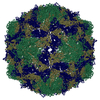

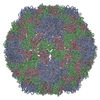
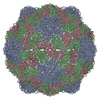
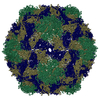

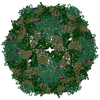
 PDBj
PDBj


